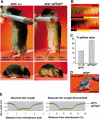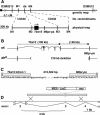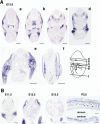Dorsoventral patterning of the mouse coat by Tbx15
- PMID: 14737183
- PMCID: PMC314463
- DOI: 10.1371/journal.pbio.0020003
Dorsoventral patterning of the mouse coat by Tbx15
Abstract
Many members of the animal kingdom display coat or skin color differences along their dorsoventral axis. To determine the mechanisms that control regional differences in pigmentation, we have studied how a classical mouse mutation, droopy ear (de(H)), affects dorsoventral skin characteristics, especially those under control of the Agouti gene. Mice carrying the Agouti allele black-and-tan (a(t)) normally have a sharp boundary between dorsal black hair and yellow ventral hair; the de(H) mutation raises the pigmentation boundary, producing an apparent dorsal-to-ventral transformation. We identify a 216 kb deletion in de(H) that removes all but the first exon of the Tbx15 gene, whose embryonic expression in developing mesenchyme correlates with pigmentary and skeletal malformations observed in de(H)/de(H) animals. Construction of a targeted allele of Tbx15 confirmed that the de(H) phenotype was caused by Tbx15 loss of function. Early embryonic expression of Tbx15 in dorsal mesenchyme is complementary to Agouti expression in ventral mesenchyme; in the absence of Tbx15, expression of Agouti in both embryos and postnatal animals is displaced dorsally. Transplantation experiments demonstrate that positional identity of the skin with regard to dorsoventral pigmentation differences is acquired by E12.5, which is shortly after early embryonic expression of Tbx15. Fate-mapping studies show that the dorsoventral pigmentation boundary is not in register with a previously identified dermal cell lineage boundary, but rather with the limb dorsoventral boundary. Embryonic expression of Tbx15 in dorsolateral mesenchyme provides an instructional cue required to establish the future positional identity of dorsal dermis. These findings represent a novel role for T-box gene action in embryonic development, identify a previously unappreciated aspect of dorsoventral patterning that is widely represented in furred mammals, and provide insight into the mechanisms that underlie region-specific differences in body morphology.
Conflict of interest statement
The authors have declared that no conflicts of interest exist.
Figures









References
-
- Agulnik SI, Papaioannou VE, Silver LM. Cloning, mapping, and expression analysis of TBX15, a new member of the T-box gene family. Genomics. 1998;51:68–75. - PubMed
-
- Altabef M, Clarke JD, Tickle C. Dorso-ventral ectodermal compartments and origin of apical ectodermal ridge in developing chick limb. Development. 1997;124:4547–4556. - PubMed
-
- Altabef M, Logan C, Tickle C, Lumsden A. Engrailed-1 misexpression in chick embryos prevents apical ridge formation but preserves segregation of dorsal and ventral ectodermal compartments. Dev Biol. 2000;222:307–316. - PubMed
-
- Barsh G, Gunn T, He L, Schlossman S, Duke-Cohan J. Biochemical and genetic studies of pigment-type switching. Pigment Cell Res. 2000;13(Suppl 8):48–53. - PubMed
-
- Begemann G, Gibert Y, Meyer A, Ingham PW. Cloning of zebrafish T-box genes tbx15 and tbx18 and their expression during embryonic development. Mech Dev. 2002;114:137–141. - PubMed
Publication types
MeSH terms
Substances
Associated data
- Actions
- Actions
- Actions
- Actions
- Actions
- Actions
- Actions
- Actions
- Actions
- Actions
- Actions
- Actions
- Actions
LinkOut - more resources
Full Text Sources
Molecular Biology Databases

